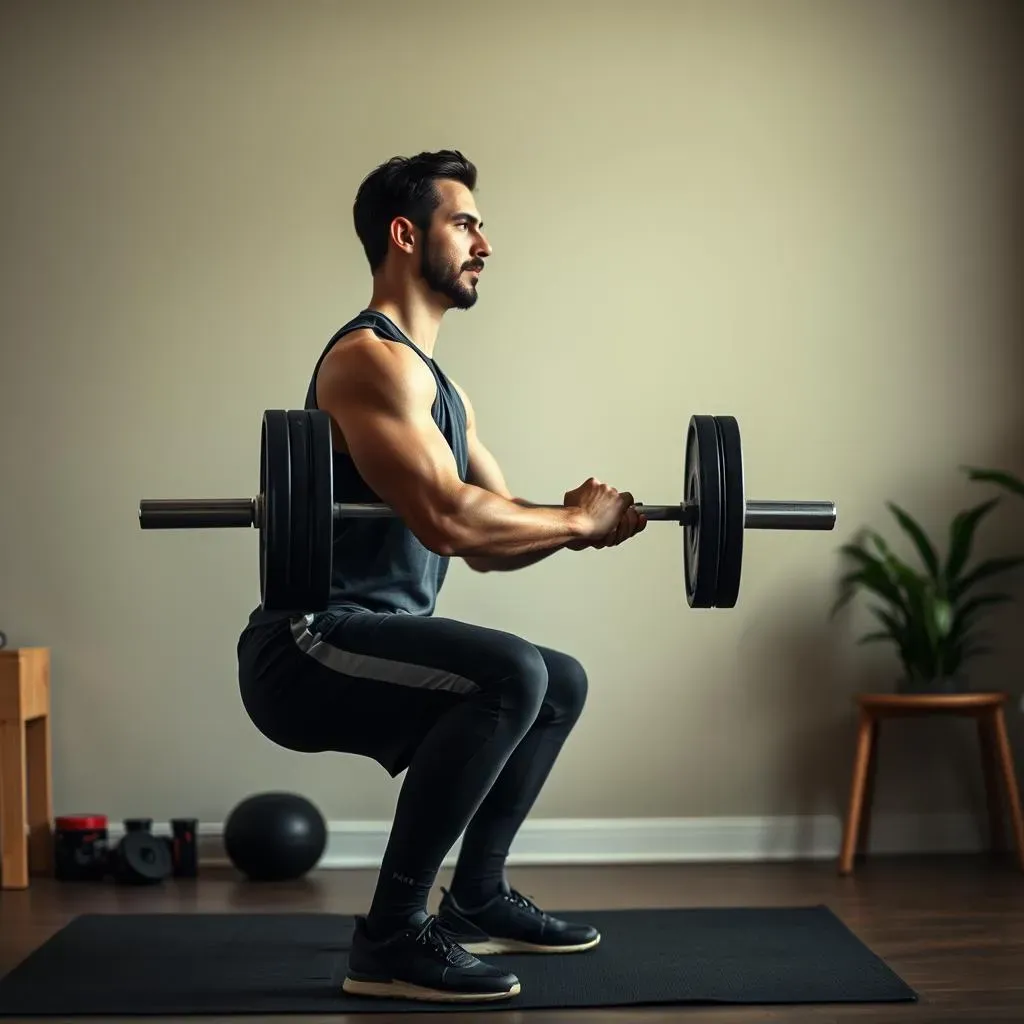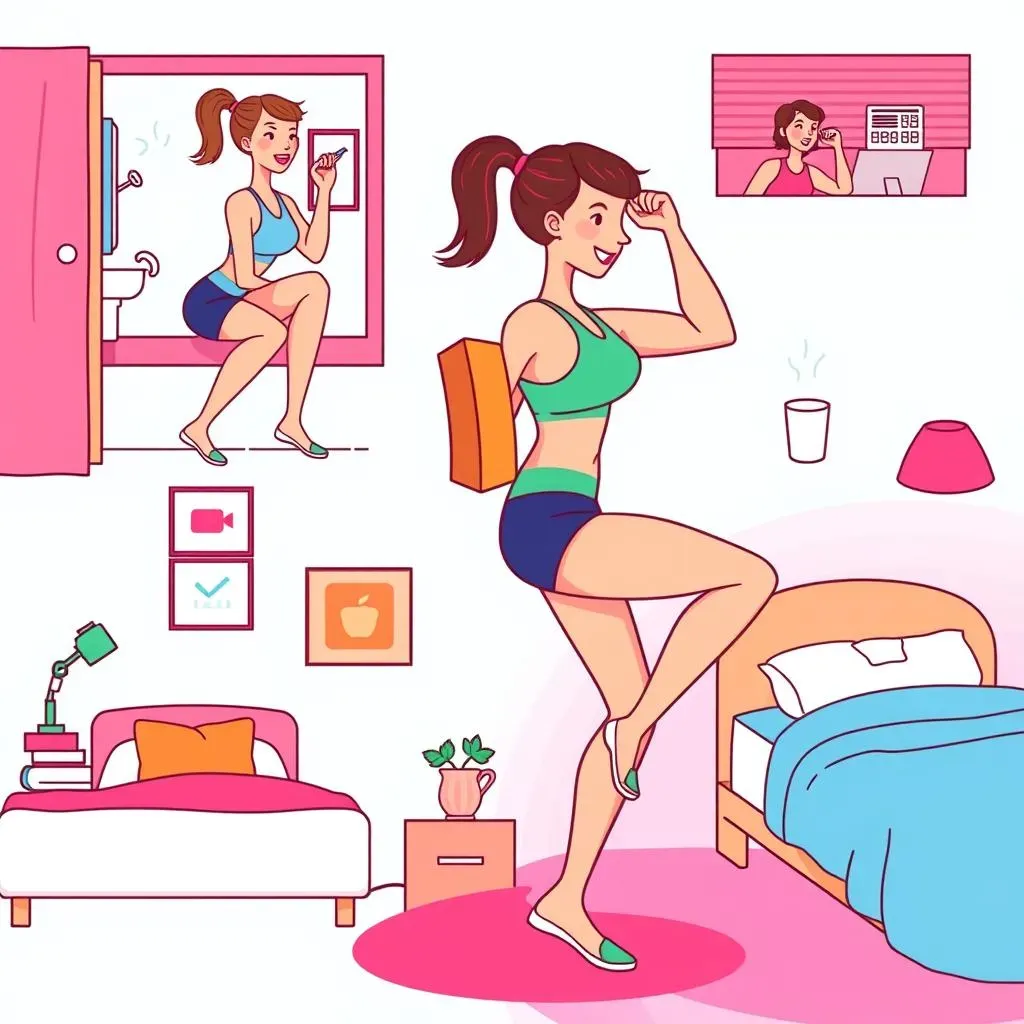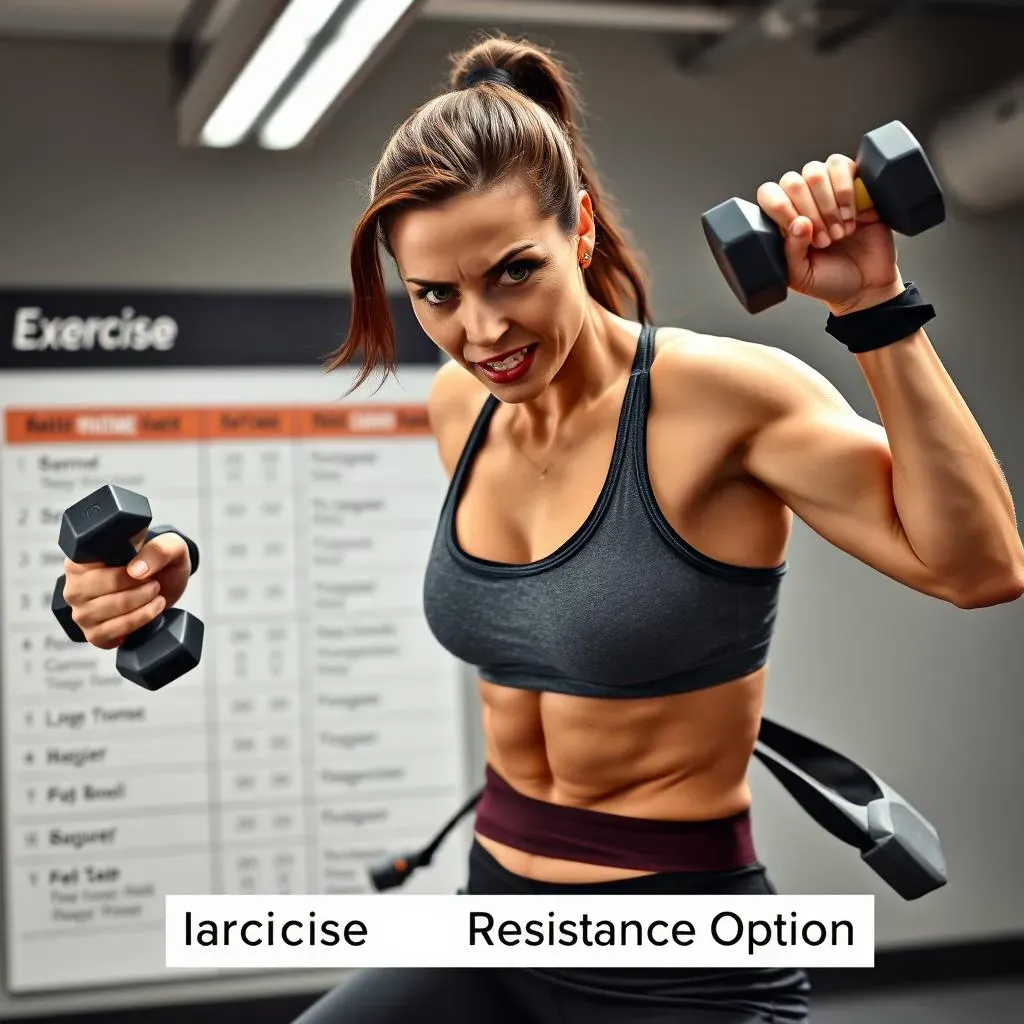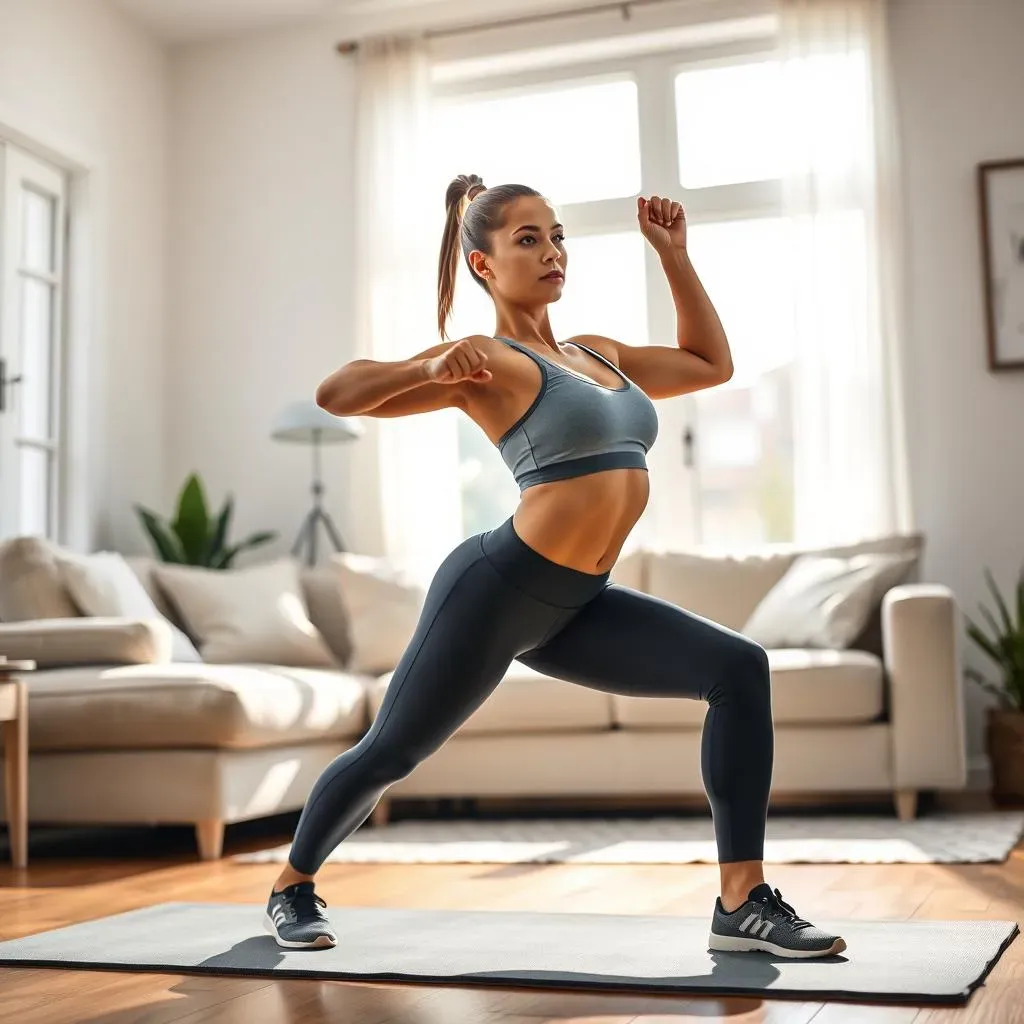Table of Contents
Let's be real, life gets hectic. Between work, family, and everything else, finding time for the gym can feel impossible. But what if I told you that you could build a stronger, more sculpted backside without ever stepping foot in a gym? Forget expensive equipment and long commutes – we’re talking about effective butt workouts at home for busy schedules. Your glutes aren't just for show; they're the powerhouse behind many of your movements. Weak glutes can lead to back pain, poor posture, and even that dreaded "dead butt syndrome." This article will guide you through 14 simple yet powerful exercises you can do anywhere, anytime. I'll show you how to fit these quick routines into your jam-packed day, plus give you tips on how to level up as you get stronger. Get ready to transform your backside, no matter how busy you are. It's time to make those glutes work for you!
Why Your Glutes Need Attention: More Than Just Looks

Why Your Glutes Need Attention: More Than Just Looks
Okay, so you might think glutes are all about aesthetics, right? Like, a nice-looking backside. And yeah, that's a bonus, but trust me, they're way more important than that! Your glutes are the biggest muscles in your body, and they're crucial for everything from walking to jumping to just standing up straight. They're the workhorses that power your lower body. Ignoring them is like ignoring the engine in your car – things are going to break down. When your glutes are weak, other muscles have to pick up the slack, leading to things like lower back pain, knee problems, and even poor posture. So, we need to stop thinking of glute work as just vanity and start seeing it as an essential part of overall health and performance. Think of your glutes like the foundation of a house; if they're not strong, everything else is going to suffer.
14 ButtKicking Exercises You Can Do at Home

14 ButtKicking Exercises You Can Do at Home
Get Ready to Feel the Burn:
Bodyweight Basics
Alright, let's get to the good stuff – the exercises! You don't need fancy gym equipment to build a strong and toned backside. We're starting with bodyweight moves, which are perfect for beginners and can still challenge even the most seasoned fitness enthusiasts. These moves are all about using your own body as resistance, which is surprisingly effective. We'll be focusing on proper form to maximize results and prevent injuries. Remember, it’s better to do fewer reps with good form than a bunch of sloppy ones. So, focus on engaging those glutes and feeling the burn. We’re going to be doing squats, lunges, glute bridges, and a few other moves that'll have your glutes screaming (in a good way, of course!).
Think of these exercises like the building blocks of a strong lower body. Each one targets your glutes in a slightly different way, ensuring you're getting a well-rounded workout. Don't worry if you can't do a million reps right away; start with what you can handle and gradually increase the number as you get stronger. I'm a big believer in listening to your body. If something doesn't feel right, stop and adjust. The goal is to challenge yourself, not hurt yourself. You should be feeling a good burn in your glutes, not pain in your joints. Consistency is key; even a few minutes of focused work each day will make a big difference.
Exercise | Reps | Sets | Why it's awesome |
|---|---|---|---|
Squats | 10-15 | 3 | Classic for a reason, hits all glute muscles |
Lunges | 10-12 per leg | 3 | Works each leg individually, great for balance |
Glute Bridges | 15-20 | 3 | Excellent for isolating the glutes |
Donkey Kicks | 15-20 per leg | 3 | Targets upper glutes |
Fire Hydrants | 15-20 per leg | 3 | Works the outer glutes |
More Moves to Maximize Your Results:
Expanding Your Arsenal
Okay, now that you've got the basics down, let's add a few more moves to the mix. These exercises will help you hit your glutes from different angles, ensuring a more complete workout. We're going to throw in some single-leg moves, some lateral movements, and even a little bit of plyometrics. Don't let the fancy names scare you; they're all totally doable at home. I'm talking about things like single-leg deadlifts, curtsy lunges, and step-ups. These moves not only work your glutes but also challenge your balance and coordination. Plus, they'll keep your workouts interesting and prevent you from getting bored. Variety is the spice of life, and the spice of a good butt workout!
Remember, the goal here is to challenge yourself while maintaining proper form. If you're new to these exercises, start slowly and focus on quality over quantity. You can always modify the moves to make them easier or harder. For example, you can do step-ups on a low stool or a stair, or you can add a little weight to your single-leg deadlifts if you're feeling adventurous. The key is to listen to your body and progress gradually. The more you practice, the stronger you'll get, and the more you'll be able to push yourself. So, let's get to it and make those glutes work!
Making Time for Your Butt: Fitting Workouts into a Busy Day

Making Time for Your Butt: Fitting Workouts into a Busy Day
Sneaking in a Few Minutes:
The Power of Micro-Workouts
Okay, so you're busy, I get it. But here's the thing: you don't need to spend hours in the gym to get results. The key is to be smart about how you use your time. Think of it like this, instead of trying to fit in one big workout, try sneaking in little mini-workouts throughout the day. I'm talking about 5-10 minutes here and there. A few squats while you're waiting for your coffee to brew, some lunges while you're on a work call, or a quick set of glute bridges before you hop in the shower. These micro-workouts might seem small, but they add up over time. It's like saving a little bit of money each day, it doesn't seem like much at first, but eventually, you have a nice chunk of change. Consistency is way more important than intensity when you're just starting out.
The beauty of these micro-workouts is that they fit into any schedule. No need to change your entire day to accommodate a workout; you are simply adding small pockets of fitness. I know that sometimes finding even a few minutes can feel like a challenge, but try to be creative! Maybe you can do some squats while you're brushing your teeth, or some donkey kicks while you're watching TV. The point is to make it part of your normal routine, not something extra you have to think about. The more you do it, the more it will become a habit, and the easier it'll be to stay consistent. Plus, those little bursts of activity will give you an energy boost and make you feel good throughout the day!
Time | Activity | Exercise |
|---|---|---|
While brushing teeth | Standing still | Squats |
During work calls | Walking around | Lunges |
Before shower | On the floor | Glute Bridges |
While watching TV | On the floor | Donkey Kicks |
Planning Your Week:
Scheduling Your Glute Gains
While those mini-workouts are great for sneaking in extra activity, it's also a good idea to plan a couple of longer sessions each week. Think of these as your main glute-focused workouts. Pick a couple of days where you have a little more time, and schedule in a 20-30 minute workout. This doesn't have to be a huge commitment; it's just about being intentional with your time. Treat it like an appointment you can't miss! You can use the exercises I gave you earlier, or you can find some other routines online. The key is to make it a regular part of your week. I find that if I put it in my calendar, I'm much more likely to stick with it. It's easy to say "I'll do it later," but "later" never comes if you don't plan for it.
To help you with planning, I suggest picking a couple of days that work best for you and set up a reminder on your phone. This will help you stay on track. Don't worry if you miss a day here or there; life happens. The important thing is to get back on track as soon as you can. The goal here is not to be perfect, but to be consistent. Consistency is what builds muscle and makes a difference. I know that sometimes starting is the hardest part, but once you get going, it's much easier to keep the momentum going. So, find your time, schedule your workouts, and get ready to feel the burn!
Making it a Habit:
Sticking With It Long-Term
Alright, so you've started doing some workouts, you've scheduled some time, and you're feeling good. But how do you make sure you stick with it long-term? The key is to make it a habit, not just something you do when you feel like it. Think of it like brushing your teeth; you don't skip it because you don't feel like it, you do it because it's part of your routine. The same goes for your glute workouts. Find a way to incorporate them into your daily life so that they become second nature. This could be setting a specific time each day or creating a visual cue that reminds you to move, or even finding a workout buddy to keep you accountable. It's all about finding what works best for you.
I know that sometimes it can be hard to stay motivated, especially when you're busy. But remember why you started in the first place. You want to feel stronger, healthier, and more confident. You want to prevent those pesky aches and pains, and, let's be honest, you want a nice-looking backside! So, keep that goal in mind, and don't give up. It's okay if you have a bad day or if you miss a workout. Just get back on track the next day. The most important thing is to keep showing up for yourself, even when it's hard. The results are worth it. So, stick with it, and you will achieve your goals!
Level Up Your Glute Game: Variations and Progressions

Level Up Your Glute Game: Variations and Progressions
Adding Resistance:
Weights and Bands
Alright, so you've mastered the bodyweight basics, and you're feeling pretty good. But what if I told you that you could make those exercises even more challenging? It's time to introduce resistance! This doesn't mean you need a bunch of fancy gym equipment. You can use simple things like dumbbells, resistance bands, or even household items like water bottles or cans. Adding resistance is like turning up the volume on your workout; it forces your muscles to work harder, leading to greater strength and definition. Think of it like this: if you always lift the same weight, your muscles will adapt. By adding resistance, you are always pushing your body to be better.
You can add resistance to almost any of the exercises we've talked about. For squats, you can hold dumbbells at your sides or across your chest. For lunges, you can hold dumbbells or wear a backpack with some weight in it. For glute bridges, you can put a weight plate or a resistance band across your hips. For donkey kicks and fire hydrants, you can use resistance bands around your ankles. Start with light weights or low-resistance bands, and gradually increase the resistance as you get stronger. Remember, the goal is to challenge yourself, not hurt yourself. So, listen to your body and increase the resistance when you feel ready. The added challenge will make your glutes work even harder and see faster progress.
Exercise | Resistance Option | Why it's awesome |
|---|---|---|
Squats | Dumbbells, Kettlebell | Increases overall muscle activation |
Lunges | Dumbbells, Weighted Vest | Adds extra challenge to each leg |
Glute Bridges | Weight plate, Resistance band | Maximizes glute engagement |
Donkey Kicks | Resistance band around ankles | Adds an extra burn to the upper glutes |
Changing the Tempo and Angles:
Variations for Advanced Gains
Okay, so you've got the resistance down, but what if I told you there are even more ways to challenge your glutes? It's time to start playing with tempo and angles. This means slowing down your movements, adding pauses, and changing the direction in which you move. For example, instead of doing regular squats, you can try slow squats where you lower down for three seconds, hold for one second, and then come back up for three seconds. Or, you can try pulse squats where you stay in the lowered position and do small pulses. You can also try different angles, like sumo squats with a wider stance or curtsy lunges that work the glutes from a different direction. The key is to keep your muscles guessing and prevent them from getting used to the same old routine.
These variations might seem small, but they make a huge difference. Slowing down the movements forces your muscles to work harder and increases the time under tension, which is great for building strength. Adding pauses increases the intensity of the exercise and really makes your muscles burn. Changing the angles hits your glutes from different directions, ensuring a more complete workout. Plus, these variations keep your workouts interesting and prevent you from getting bored. It’s easy to get stuck in a rut doing the same exercises over and over, but by adding these variations, you are keeping it fresh and exciting. So, get creative and start experimenting with different tempos and angles. You’ll be amazed at how much you can challenge your glutes with just a few simple tweaks.
Plyometrics and Explosive Movements:
Adding Power to Your Glutes
Alright, you've mastered the basics, added resistance, and played with tempo and angles. Now, let's add some power! Plyometrics are exercises that involve jumping and explosive movements. These exercises not only work your glutes but also improve your overall power and athleticism. Think of it like this: if you want to be able to jump higher, run faster, and feel more powerful, you need to train your muscles to move explosively. These exercises are not just about building strength, they are also about building power, speed, and agility. I'm talking about things like jump squats, box jumps, and plyometric lunges. These moves are all about using your glutes to generate force and propel your body into the air.
These exercises are more advanced, so it’s important to start slowly and make sure you have a good base of strength before trying them. Start with a few reps and gradually increase the number as you get stronger. Focus on landing softly to prevent injuries, and always make sure you have good form. If you are new to plyometrics, you can start with smaller jumps and gradually increase the height as you get more comfortable. These movements are a great way to challenge your glutes and take your fitness to the next level. So, add some plyometrics to your routine and get ready to feel the power in your glutes!
